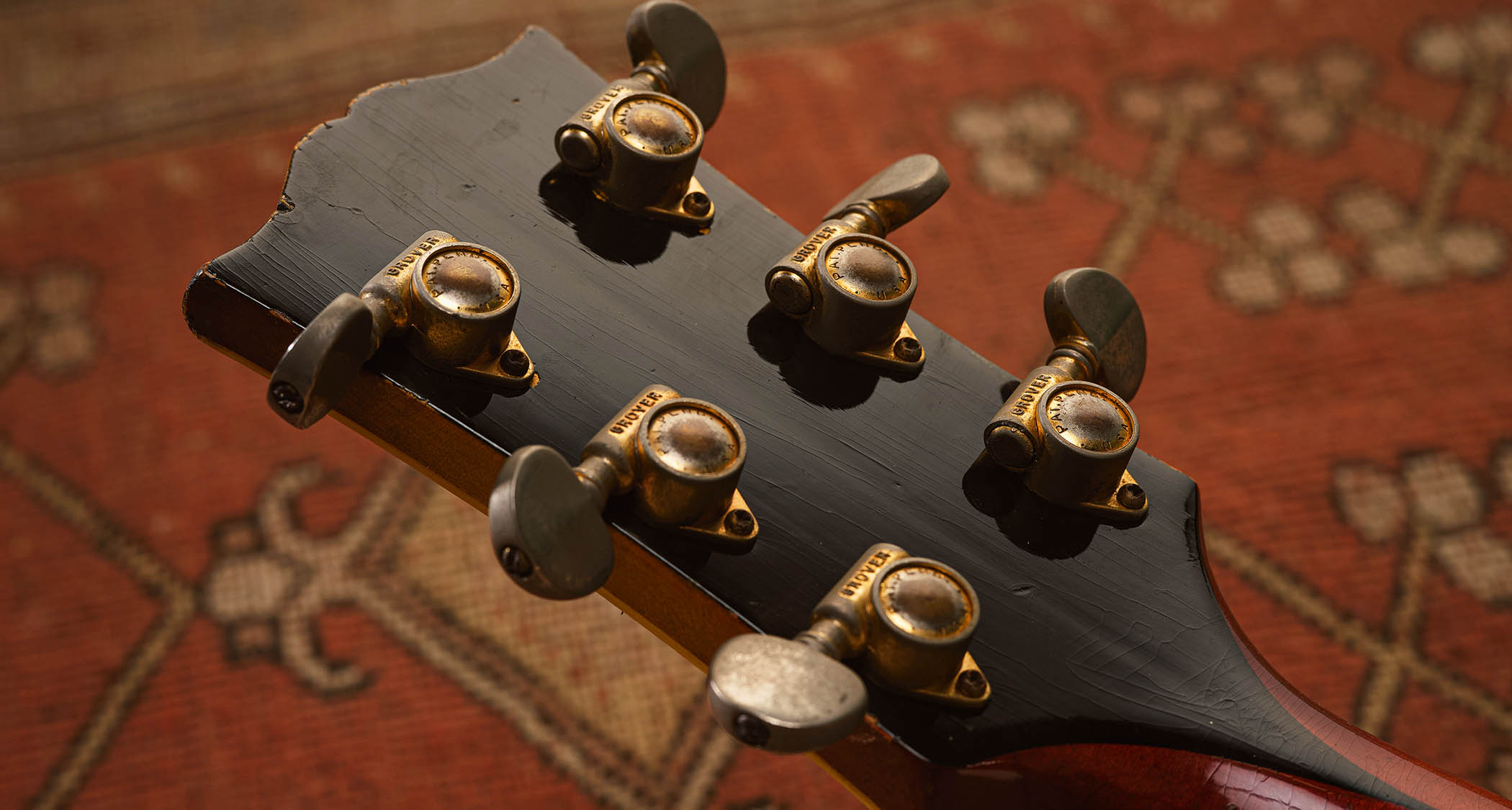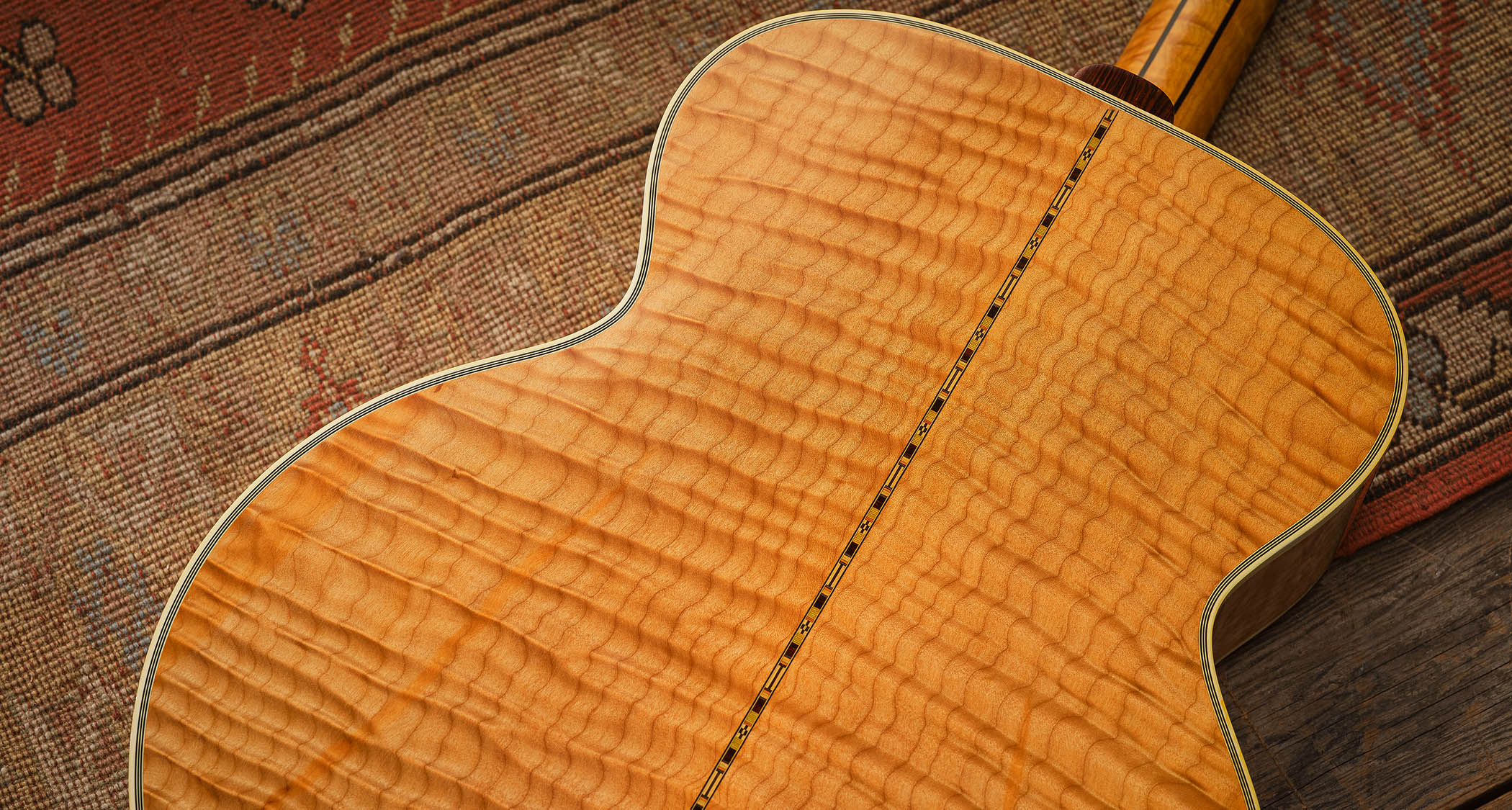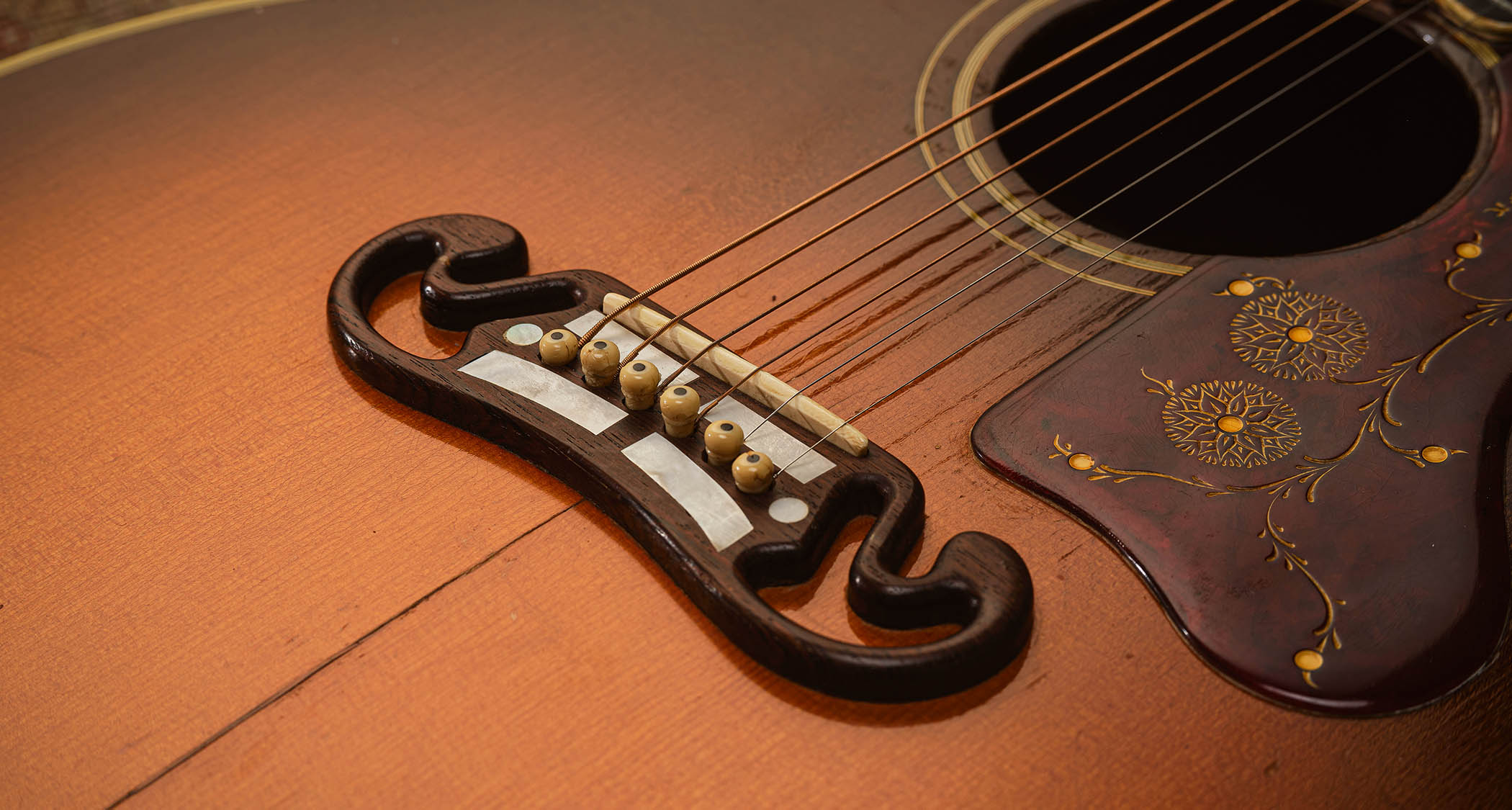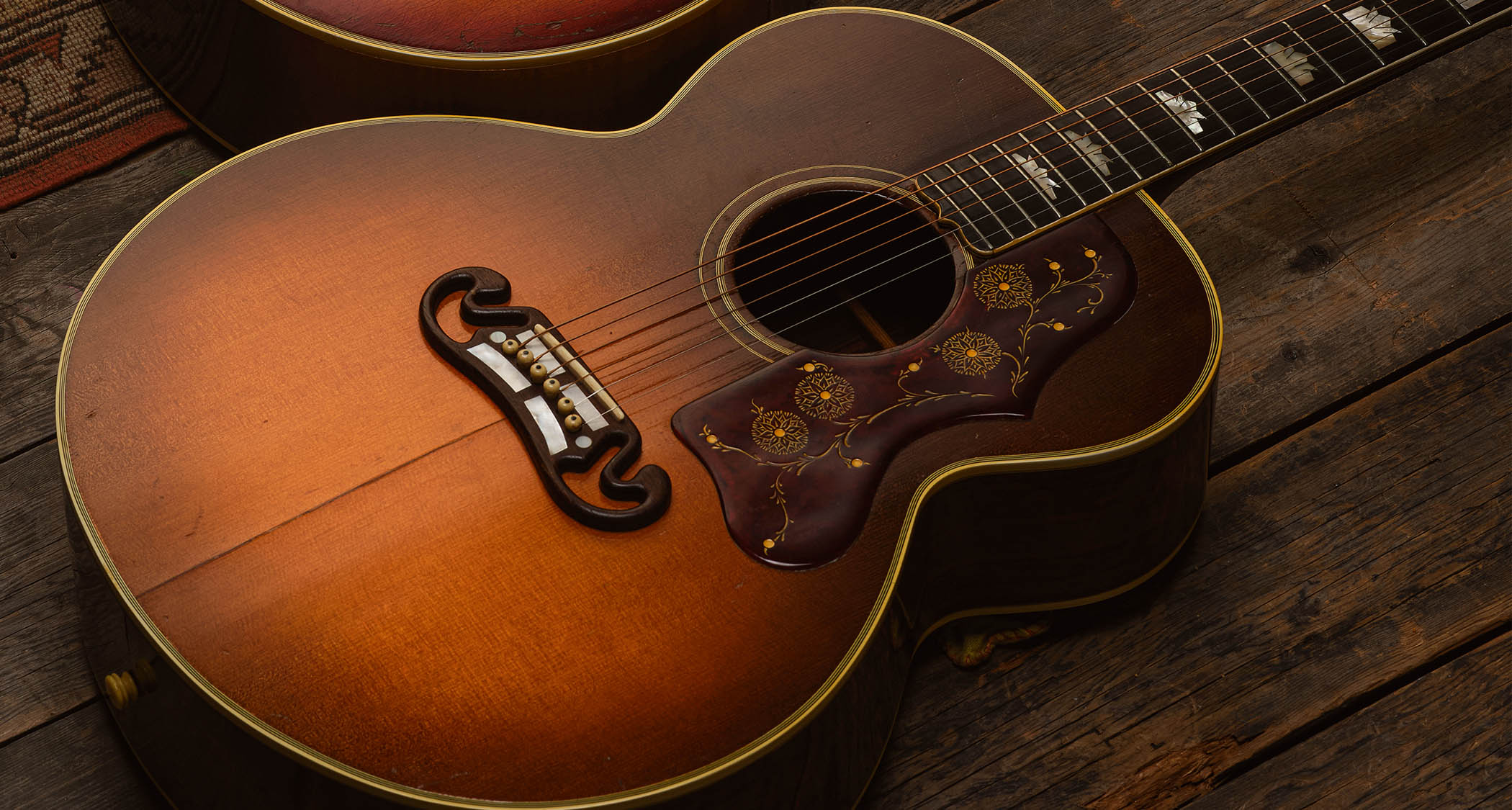
Sometimes referred to as a ‘narrow waist jumbo’, the J-200 is the model that unites Roy Rogers with Elvis, Pete Townshend, Bob Dylan, Emmylou Harris, Yusuf/Cat Stevens, Noel Gallagher and countless others.
Since the very first one was presented to Ray Whitley in December 1937, it has been a constant in Gibson’s product line barring a brief pause during America’s participation in WWII.
Ray Whitley was a singing cowboy film star during the 1930s. When appearing at the Madison Square Garden rodeo, he got together with Guy Hart from Gibson to discuss ideas for a new acoustic guitar model. Ray’s dream guitar was a flat-top version of Gibson’s flagship 17-inch L-5 archtop, and he spent a week at the factory helping to design it.
As a stage performer, Ray also wanted his guitar to be eye-catching and Gibson obliged with a sunburst finish, gold hardware, a fancy ‘moustache’ bridge and multi-layer black/white binding applied to the body. The neck and headstock were also bound and the ‘cloud’ fretboard inlays were specially made. The celluloid pickguard’s shape was derived from the Super 400 and adorned with an engraved border and flower motifs.
At first, the model designation was ‘Super Jumbo’, which differentiated Ray’s guitar from the smaller ‘Advanced Jumbo’ model that Gibson made between 1936 and 1938. In 1939, the name was altered to Super Jumbo 200, and the designation SJ-200 was subsequently used until 1955 when it was shortened to J-200.
Pre-WWII SJ-200
This model’s case screams jazz-age Gibson and its tweed covering and contrasting black-and-red stripes resemble an EH-185 amplifier. Inside is a pink velour lining and a metal name badge reading ‘Geib, Chicago’. Assuming this is the original case, it’s still in great shape and it’s kept this rosewood and spruce SJ-200 in remarkable condition.
A mystery over the exact manufacturing date arises because no serial number or FON stamp can be seen and certain details don’t conform to the usual feature timeline. Up until 1941, Gibson fitted ebony fretboards with a pointed shape at the soundhole end, and this example has both.
They also changed to pearloid tulip-buttoned tuners, but here we see the earlier ‘stair step’ Grover imperials. The bridge confuses the issue because pre-1941 SJ-200s should have six individually adjustable threaded bone saddles.
Instead, this example has the later straight bone saddle. There is no evidence of the bridge having been altered, but the lightness of the sunburst may offer clues.

Very early SJ-200s tend to have dark sunbursts, but this one looks like most of the red has faded away to leave the shading tints over a deep amber base coat. It’s exactly what has happened to the aniline red of so many late 1950s Les Pauls, so it could be that the guitar was sent back to Gibson for a refinish and the bridge was changed at the same time.
Until relatively recently, it was common for professional musicians to return their stage guitars to the original manufacturer for refurbishment. But the finish is several decades old and some lacquer chips around the bridge may indicate that it’s simply a very faded original finish with a replaced bridge.
The pickguard could also be an area of concern due to the absence of an engraved border. Gibson dispensed with the border in 1955, but a video with ‘Ranger Doug’ Green playing Rosalie Allen’s 1938 Gibson SJ-200 clearly shows that her pickguard was border-free, too, so we need to look inside.

The earliest SJ-200s had two 128-degree X braces, with one supporting the bridge and the other the upper bout. Two transverse ‘ladder’ braces were also fixed behind the lower-bout X brace. In 1941, Gibson changed to a single X brace with angled tone bars but reverted to the double X with ladder bars around 1952.
Considering the combination of double X-bracing, Indian rosewood back and sides, ebony fretboard, pre-1948 style headstock binding, script logo and tuners, all the evidence suggests this SJ-200 was made prior to 1941.
The 17-inch body width and centre strip ‘zipper’ inlay were introduced after 1938, so we’re suggesting a manufacturing date somewhere between 1939 and early 1941 at the latest.

1959 J-200

In contrast to its older sibling, there is no mystery about this J-200. The serial number and FON stamp on the neck block both correspond with a production year of 1959. In fact, experienced vintage guitar enthusiasts could probably hazard a guess from the neck profile alone because it wouldn’t feel out of place on a 1959 Les Paul.
All the other ’50s features are present, from gold-plated Grover Rotomatic tuners to single-ply headstock binding, a Brazilian rosewood fretboard and a lighter red, borderless pickguard. But most significant is the change to maple back and sides that occurred in 1947.

The maple is beautifully figured on the back, with the sides slightly muted but still displaying some curl, while the cherry sunburst has very little fade, retaining the same dark edges and vibrant red – front and back.
The maple neck is very plain compared with both the body and the SJ-200’s heavily flamed two-piece neck. A factory applied stinger on the back of the headstock gracefully tapers into a rosewood fillet that runs the length of the neck.
At first glance, the bridges look indistinguishable, but the SJ-200’s is taller. Digital callipers confirm this, with the early bridge measuring around 8.25mm and the J-200’s closer to 4.5mm. Perhaps the ’59 bridge had been shaved down to lower the action, but with the top edges so beautifully rounded and no evidence of any work having been done, we feel that’s unlikely.

1984 J-200
Of the three guitars featured here, the youngest and least valuable actually has a claim to being the most historically significant. In addition to being the last J-200 produced in Gibson’s Kalamazoo factory, it’s the very last flat-top acoustic ever made there.
The ’59’s back was impressive enough, but the quilting on this example is simply outrageous
It’s no surprise that the Custom Shop pulled out the stops for this one, and not all the features are typical of J-200s. There’s a rosewood peghead overlay and truss rod cover, and an engraved rosewood pickguard with edge binding. All the rosewood parts on this guitar, including the fretboard, appear to be Brazilian.
The ’59’s back was impressive enough, but the quilting on this example is simply outrageous. The figuring extends to the sides and the three-piece maple neck. And to top it off, there’s an engraved mother-of-pearl headstock plaque to commemorate this guitar’s place in Gibson history.
Other decorative appointments include a multi-coloured back strip and multi-ply binding around the back. It feels slightly bigger than both the others and a quick check reveals that, at 5.25 inches, the body is slightly deeper.

Heavyweight Contest
The pre-WWII SJ-200 sounds utterly huge with very deep and punchy bass, strong mids and clear highs. The tone is laden with harmonics and yet there’s an even balance all across the frequency range. The dynamic range is astonishing, with the guitar responding to a feather-light touch as well as strong-armed strumming. Try as we might, we couldn’t push the top beyond its limits.
Measuring 44.75mm at the nut with a string spacing of 37.75mm, the SJ-200 is built for dedicated acoustic players, but the surprisingly slim and soft-shouldered neck profile is extremely comfortable. The only criticism that some might level is that its sonic signature doesn’t meet expectations of vintage J-200 tone quite like the ’59.
Maple-backed acoustics are often erroneously assumed to be bright, but here it’s like someone has activated an imaginary bass roll-off instead
Maple-backed acoustics are often erroneously assumed to be bright, but here it’s like someone has activated an imaginary bass roll-off instead. Playing the ’59 is an altogether calmer and more intimate experience. It sounds beautifully freed up, with the dry midrange and warm trebles that provide so much of the vintage Gibson allure.
This guitar effortlessly generates the J-200 songs you’ve heard on countless records. With a 43mm nut width and 36mm string spacing, the fuller ’50s neck feels sublime, but the replaced saddle doesn’t do the top E any favours and we suspect the guitar would benefit from a new one.

The ’84 has the best setup, is the easiest to play, and more than holds its own with the other two. Sonically, it slots neatly between its older siblings, with deeper bass, extra sustain and more harmonic overtones than the ’59 but less of the vintage woodiness.
The neck width and string spread are very close to the ’59’s, but the neck profile is remarkably similar to the SJ-200’s. Judging by its condition, the ’84 has barely been played over the past 40 years and we suspect that this already fine-sounding J-200 still has unreleased potential.
Let’s put these guitars on a piano scale, with a 1920s catalogue parlour at the out-of-tune honky-tonk end of the spectrum: the ’59 is like a fine-quality upright, the ’84 resembles a domestic baby grand, and SJ-200 is a concert hall Bechstein. Playing all three has been a privilege.
- With thanks to Vintage ‘n’ Rare Guitars in Bath, where the 1984 J-200 is for sale, for the kind loan of these guitars.







